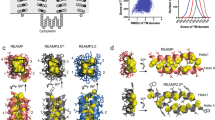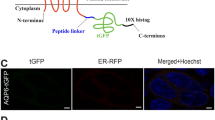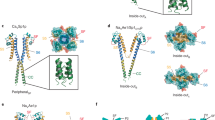Abstract
Aquaporin (AQP) folding in the endoplasmic reticulum is characterized by two distinct pathways of membrane insertion that arise from divergent residues within the second transmembrane segment. We now show that in AQP1 these residues (Asn49 and Lys51) interact with Asp185 at the C terminus of TM5 to form a polar, quaternary structural motif that influences multiple stages of folding. Asn49 and Asp185 form an intramolecular hydrogen bond needed for proper helical packing, monomer formation and function. In contrast, Lys51 interacts with Asp185 on an adjacent monomer to stabilize the AQP1 tetramer. Although these residues are unique to AQP1, they share a highly conserved architecture whose functional properties can be transferred to other family members. These findings suggest a general mechanism by which evolutionary divergence of membrane proteins can confer new functional properties via alternative folding pathways that give rise to a common final structure.
This is a preview of subscription content, access via your institution
Access options
Subscribe to this journal
Receive 12 print issues and online access
$189.00 per year
only $15.75 per issue
Buy this article
- Purchase on Springer Link
- Instant access to full article PDF
Prices may be subject to local taxes which are calculated during checkout







Similar content being viewed by others
References
Alder, N.N. & Johnson, A. Cotranslational membrane protein biogenesis at the endoplasmic reticulum. J. Biol. Chem. 279, 22787–22790 (2004).
Higy, M., Junne, T. & Spiess, M. Topogenesis of membrane proteins at the endoplasmic reticulum. Biochemistry 43, 12716–12722 (2004).
Pitonzo, D. & Skach, W. Molecular mechanisms of aquaporin biogenesis by the endoplasmic reticulum Sec61 translocon. Biochim. Biophys. Acta. 1758, 976–988 (2006).
Osborne, A.R., Rapoport, T.A. & van den Berg, B. Protein translocation by the Sec61/SecY channel. Annu. Rev. Cell Dev. Biol. 21, 529–550 (2005).
Skach, W.R. & Lingappa, V. Amino terminus assembly of human P-glycoprotein at the endoplasmic reticulum is directed by cooperative actions of two internal sequences. J. Biol. Chem. 268, 23552–23561 (1993).
Heinrich, S.U. & Rapoport, T. Cooperation of transmembrane segments during integration of a double-spanning protein into the ER membrane. EMBO J. 22, 3654–3663 (2003).
Sadlish, H., Pitonzo, D., Johnson, A.E. & Skach, W.R. Sequential triage of transmembrane segments by Sec61α during biogenesis of a native multispanning membrane protein. Nat. Struct. Mol. Biol. 12, 870–878 (2005).
McCormick, P.J., Miao, Y., Shao, Y., Lin, J. & Johnson, A. Cotranslational protein integration into the ER membrane is mediated by the binding of nascent chains to translocon proteins. Mol. Cell 12, 329–341 (2003).
Popot, J.L. & Engelman, D. Helical membrane protein folding, stability and evolution. Annu. Rev. Biochem. 69, 881–922 (2000).
Bowie, J.U. Solving the membrane protein folding problem. Nature 438, 581–589 (2005).
Booth, P.J. & High, S. Polytopic membrane protein folding and assembly in vitro and in vivo. Mol. Membr. Biol. 21, 163–170 (2004).
Gratkowski, H., Lear, J. & DeGrado, W. Polar side chains drive the association of model transmembrane peptides. Proc. Natl. Acad. Sci. USA 98, 880–885 (2001).
Zhou, F.X., Cocco, M., Russ, W., Brunger, A. & Engelman, D. Interhelical hydrogen bonding drives strong interactions in membrane proteins. Nat. Struct. Biol. 7, 154–160 (2000).
Sui, H., Han, B.-G., Lee, J., Walian, P. & Jap, B. Structural basis of water specific transport through the AQP1 water channel. Nature 414, 872–878 (2001).
Fu, D. et al. Structure of a glycerol-conducting channel and the basis for its selectivity. Science 290, 481–486 (2000).
Savage, D.F., Egea, P., Robles-Colmenares, Y., O'Connell, J.D. & Stroud, R. Architecture and selectivity in aquaporins: 2.5 Å X-ray structure of aquaporin Z. PLoS Biol. 1, E72 (2003).
Harries, W.E. et al. The channel architecture of aquaporin 0 at a 2.2-Å resolution. Proc. Natl. Acad. Sci. USA 101, 14045–14050 (2004).
King, L.S., Kozono, D. & Agre, P. From structure to disease, the evolving tale of aquaporin biology. Nat. Rev. Mol. Cell Biol. 5, 687–698 (2004).
Fujiyoshi, Y. et al. Structure and function of water channels. Curr. Opin. Struct. Biol. 12, 509–515 (2002).
Verkman, A.S. More than just water channels: unexpected cellular roles of aquaporins. J. Cell Sci. 118, 3225–3232 (2005).
Murata, K. et al. Structural determinants of water permeation through aquaporin-1. Nature 407, 599–605 (2000).
Manley, D.M. et al. Secondary structure and oligomerization of the E. coli glycerol transporter. Biochemistry 39, 12303–12311 (2000).
Roudier, N. et al. Erythroid expression and oligomeric state of the AQP3 protein. J. Biol. Chem. 277, 7664–7669 (2002).
Verbavatz, J.M. et al. Tetrameric assembly of CHIP28 water channels in liposomes and cell membranes. A freeze-fracture study. J. Cell Biol. 123, 605–618 (1993).
Van Hoek, A.N. et al. Purification and structure-function analysis of native, PNGase F-treated, and endo-β-galactosidase-treated CHIP28 water channels. Biochemistry 34, 2212–2219 (1995).
Nielsen, S. & Agre, P. The aquaporin family of water channels in the kidney. Kidney Int. 48, 1057–1068 (1995).
Brown, D., Katsura, T., Kawashima, M., Verkman, A. & Sabolic, I. Cellular distribution of the aquaporins: a family of water channel proteins. Histochem. Cell Biol. 104, 1–9 (1995).
Duchesne, L. et al. Role of C-terminal domain and transmembrane helices 5 and 6 in function and quaternary structure of major intrinsic proteins: analysis of aquaporin/glycerol facilitator chimeric proteins. J. Biol. Chem. 277, 20598–20604 (2002).
Lagrée, V. et al. Oligomerization state of water channels and glycerol facilitators. Involvement of loop E. J. Biol. Chem. 273, 33949–33953 (1998).
Shi, L.-B., Skach, W., Ma, T. & Verkman, A. Distinct biogenesis mechanisms for water channels MIWC and CHIP28 at the endoplasmic reticulum. Biochemistry 34, 8250–8256 (1995).
Foster, W. et al. Identification of sequence determinants that direct different intracellular folding pathways for AQP1 and AQP4. J. Biol. Chem. 275, 34157–34165 (2000).
Skach, W.R. et al. Biogenesis and transmembrane topology of the CHIP28 water channel in the endoplasmic reticulum. J. Cell Biol. 125, 803–815 (1994).
Lu, Y. et al. Reorientation of Aquaporin-1 topology during maturation in the endoplasmic reticulum. Mol. Biol. Cell 11, 2973–2985 (2000).
Buck, T.M. & Skach, W. Differential stability of biogenesis intermediates reveals a common pathway for aquaporin-1 topological maturation. J. Biol. Chem. 280, 261–269 (2005).
Heijne, G.V. The distribution of positively charged residues in bacterial inner membrane proteins correlates with trans-membrane topology. EMBO J. 5, 3021–3027 (1986).
Preston, G.M., Jung, J., Guggino, W. & Agre, P. Membrane topology of aquaporin CHIP—analysis of functional epitope-scanning mutants by vectorial proteolysis. J. Biol. Chem. 269, 1668–1673 (1994).
Partridge, A.W., Therien, A.G. & Deber, C.M. Missense mutations in transmembrane domains of proteins: phenotypic propensity of polar residues for human disease. Proteins 54, 648–656 (2004).
Sanders, C.R. & Myers, J. Disease-related misassembly of membrane proteins. Annu. Rev. Biophys. Biomol. Struct. 33, 25–51 (2004).
Johnson, A.E. & van Waes, M. The translocon: a dynamic gateway at the ER membrane. Annu. Rev. Cell Dev. Biol. 15, 799–842 (1999).
Sadlish, H. & Skach, W. Biogenesis of CFTR and other polytopic membrane proteins; new roles for the ribosome-translocon complex. J. Membr. Biol. 202, 115–126 (2004).
White, S.H. & Wimley, W. Membrane protein folding and stability: physical principles. Annu. Rev. Biophys. Biomol. Struct. 28, 319–365 (1999).
Choma, C., Gratowski, H., Lear, J. & DeGrado, W. Asparagine-mediated self-association of a model transmembrane helix. Nat. Struct. Biol. 7, 161–166 (2000).
Meindl-Beinker, N.M., Lundin, C., Nilsson, I., White, S. & von Heijne, G. Asn- and Asp-mediated interactions between transmembrane helices during translocon-mediated membrane protein assembly. EMBO Rep. 7, 1111–1116 (2006).
Oberdorf, J., Pitonzo, D. & Skach, W. An energy-dependent maturation step is required for release of the cystic fibrosis transmembrane conductance regulator from early endoplasmic reticulum biosynthetic machinery. J. Biol. Chem. 280, 38193–38202 (2005).
Robinson, J.M. & Deutsch, C. Coupled tertiary folding and oligomerization of the T1 domain of Kv channels. Neuron 45, 223–232 (2005).
Mathai, J.C. & Agre, P. Hourglass pore-forming domains restrict aquaporin-1 tetramer assembly. Biochemistry 38, 923–928 (1999).
Ren, G., Reddy, V., Shcne, A., Melnyk, P. & Mitra, A. Visualization of a water-selective pore by electron crystallography in vitreous ice. Proc. Natl. Acad. Sci. USA 98, 1398–1403 (2001).
Gonen, T. et al. Aquaporin-0 membrane junctions reveal the structure of a closed water pore. Nature 429, 193–197 (2004).
Hiroaki, Y. et al. Implications of the aquaporin-4 structure on array formation and cell adhesion. J. Mol. Biol. 355, 628–639 (2006).
de Groot, B.L., Engel, A. & Grubmueller, H. A refined structure of human aquaporin-1. FEBS Lett. 504, 206–211 (2001).
Acknowledgements
The authors thank F. Larabee for his expert technical assistance, and L. Musil, D. Koop, C. Enns and S.-L. Shyng and members of the Skach laboratory for their valuable advice and comments. This work was supported by US National Institutes of Health grants GM53457 (W.R.S.), DK51818 (W.R.S.) and T32HL07781 (T.M.B.).
Author information
Authors and Affiliations
Contributions
T.M.B. generated cDNA constructs, performed protease and coimmunoprecipitation experiments, sucrose-gradient analyses and most oocyte functional studies. J.W. contributed to cDNA cloning and performed functional oocyte studies. S.G. performed oocyte expression and coimmunoprecipitation studies. W.R.S. directed the study, designed experiments, wrote the manuscript (with T.M.B.) and analyzed AQP structures.
Corresponding author
Ethics declarations
Competing interests
The authors declare no competing financial interests.
Supplementary information
Supplementary Text and Figures
Supplementary Figs. 1–4 (PDF 554 kb)
Rights and permissions
About this article
Cite this article
Buck, T., Wagner, J., Grund, S. et al. A novel tripartite motif involved in aquaporin topogenesis, monomer folding and tetramerization. Nat Struct Mol Biol 14, 762–769 (2007). https://doi.org/10.1038/nsmb1275
Received:
Accepted:
Published:
Issue Date:
DOI: https://doi.org/10.1038/nsmb1275
This article is cited by
-
Dynamic membrane topology in an unassembled membrane protein
Nature Chemical Biology (2019)
-
Identification of a novel MIP frameshift mutation associated with congenital cataract in a Chinese family by whole-exome sequencing and functional analysis
Eye (2018)
-
Identification of a novel missense mutation of MIP in a Chinese family with congenital cataracts by target region capture sequencing
Scientific Reports (2017)
-
Plant aquaporins with non-aqua functions: deciphering the signature sequences
Plant Molecular Biology (2011)
-
An intramembrane aromatic network determines pentameric assembly of Cys-loop receptors
Nature Structural & Molecular Biology (2010)



